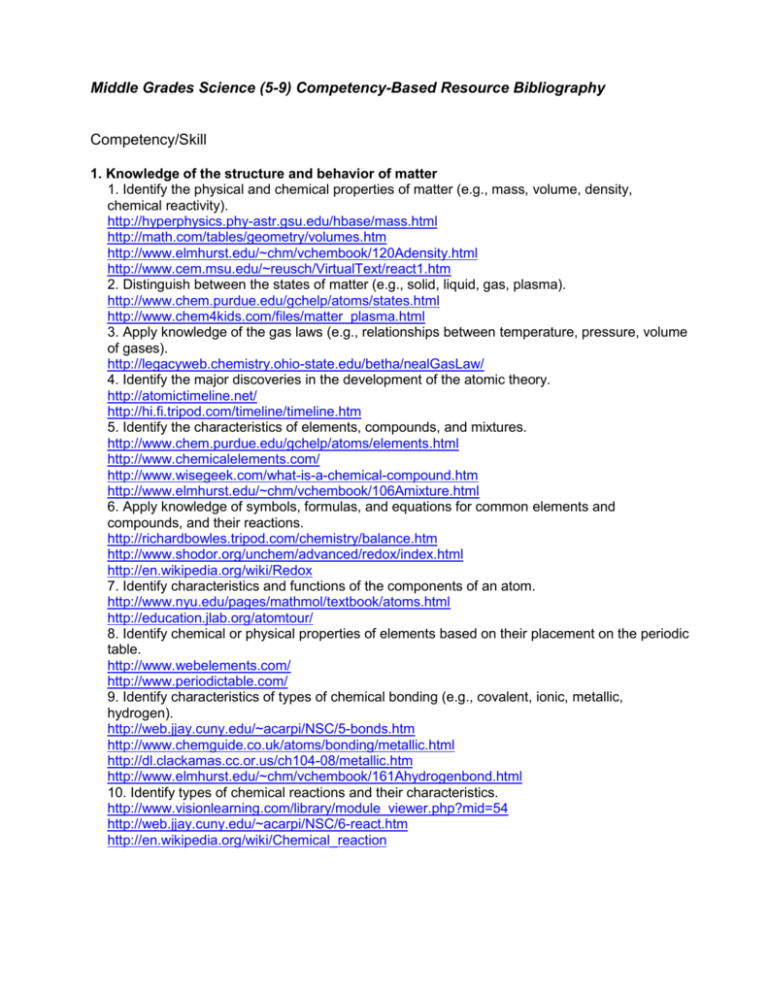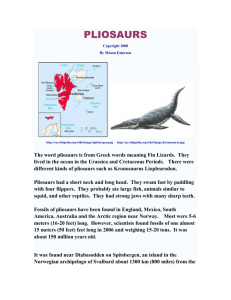MG Bibliography - SubjectAreaTestPrep
advertisement

Middle Grades Science (5-9) Competency-Based Resource Bibliography Competency/Skill 1. Knowledge of the structure and behavior of matter 1. Identify the physical and chemical properties of matter (e.g., mass, volume, density, chemical reactivity). http://hyperphysics.phy-astr.gsu.edu/hbase/mass.html http://math.com/tables/geometry/volumes.htm http://www.elmhurst.edu/~chm/vchembook/120Adensity.html http://www.cem.msu.edu/~reusch/VirtualText/react1.htm 2. Distinguish between the states of matter (e.g., solid, liquid, gas, plasma). http://www.chem.purdue.edu/gchelp/atoms/states.html http://www.chem4kids.com/files/matter_plasma.html 3. Apply knowledge of the gas laws (e.g., relationships between temperature, pressure, volume of gases). http://legacyweb.chemistry.ohio-state.edu/betha/nealGasLaw/ 4. Identify the major discoveries in the development of the atomic theory. http://atomictimeline.net/ http://hi.fi.tripod.com/timeline/timeline.htm 5. Identify the characteristics of elements, compounds, and mixtures. http://www.chem.purdue.edu/gchelp/atoms/elements.html http://www.chemicalelements.com/ http://www.wisegeek.com/what-is-a-chemical-compound.htm http://www.elmhurst.edu/~chm/vchembook/106Amixture.html 6. Apply knowledge of symbols, formulas, and equations for common elements and compounds, and their reactions. http://richardbowles.tripod.com/chemistry/balance.htm http://www.shodor.org/unchem/advanced/redox/index.html http://en.wikipedia.org/wiki/Redox 7. Identify characteristics and functions of the components of an atom. http://www.nyu.edu/pages/mathmol/textbook/atoms.html http://education.jlab.org/atomtour/ 8. Identify chemical or physical properties of elements based on their placement on the periodic table. http://www.webelements.com/ http://www.periodictable.com/ 9. Identify characteristics of types of chemical bonding (e.g., covalent, ionic, metallic, hydrogen). http://web.jjay.cuny.edu/~acarpi/NSC/5-bonds.htm http://www.chemguide.co.uk/atoms/bonding/metallic.html http://dl.clackamas.cc.or.us/ch104-08/metallic.htm http://www.elmhurst.edu/~chm/vchembook/161Ahydrogenbond.html 10. Identify types of chemical reactions and their characteristics. http://www.visionlearning.com/library/module_viewer.php?mid=54 http://web.jjay.cuny.edu/~acarpi/NSC/6-react.htm http://en.wikipedia.org/wiki/Chemical_reaction 2. Knowledge of forces and motion and their relationship 1. Differentiate between the types and characteristics of forces (e.g., electrical, magnetic, nuclear, gravitational, frictional). http://hyperphysics.phy-astr.gsu.edu/Hbase/electric/elevol.html http://www-istp.gsfc.nasa.gov/Education/Imagnet.html http://www.windows.ucar.edu/tour/link=/sun/Solar_interior/Nuclear_Reactions/Nuclear_forces/s trong.html http://hyperphysics.phy-astr.gsu.edu/hbase/forces/funfor.html http://csep10.phys.utk.edu/astr161/lect/history/newtongrav.html http://regentsprep.org/regents/physics/phys01/friction/default.htm 2. Identify applications of Newton's laws of motion. http://hyperphysics.phy-astr.gsu.edu/hbase/Newt.html http://csep10.phys.utk.edu/astr161/lect/history/newton3laws.html http://www.physicsclassroom.com/Class/newtlaws/ 3. Solve problems involving force and motion. http://library.thinkquest.org/10796/ch4/ch4.htm 4. Identify types, characteristics, and properties of waves (e.g., sound, electromagnetic, seismic, water). http://id.mind.net/~zona/mstm/physics/waves/partsOfAWave/waveParts.htm http://www.mediacollege.com/audio/01/sound-waves.html http://imagine.gsfc.nasa.gov/docs/science/know_l1/emspectrum.html http://www.geo.mtu.edu/UPSeis/waves.html http://en.wikipedia.org/wiki/Wind_wave 5. Identify characteristics of wave phenomena (e.g., intensity, refraction, diffraction, interference, Doppler effect, wave-particle duality) as they apply to everyday situations. http://physics.info/intensity/ http://en.wikipedia.org/wiki/Refraction http://www.coastal.udel.edu/ngs/waves.html http://id.mind.net/~zona/mstm/physics/waves/interference/intrfrnc.html http://archive.ncsa.illinois.edu/Cyberia/Bima/doppler.html http://www.lon-capa.org/~mmp/applist/doppler/d.htm http://en.wikipedia.org/wiki/Wave–particle_duality 6. Identify causes, characteristics, and examples of electricity (e.g., static, current). http://www.sciencemadesimple.com/static.html http://www.energyquest.ca.gov/story/chapter03.html http://en.wikipedia.org/wiki/Electric_current 7. Apply knowledge of currents, circuits, conductors, insulators, and resistors to everyday situations. http://www.allaboutcircuits.com/vol_1/chpt_7/1.html http://www.physicsclassroom.com/CLASS/circuits/ http://www.energyquest.ca.gov/story/chapter04.html 8. Identify types of magnets and characteristics of magnetic fields. http://www.coolmagnetman.com/magtypes.htm http://en.wikipedia.org/wiki/Magnetic_field 9. Apply knowledge of magnets and magnetic fields to everyday situations. http://www.physics.sjsu.edu/becker/physics51/mag_field.htm 10. Identify characteristics of motion (e.g., speed, velocity, acceleration, distance, time, units of measurement). http://physics.info/velocity/ http://physics.info/acceleration/ 3. Knowledge of energy and its effects 1. Relate energy to transitions between states of matter. http://web.jjay.cuny.edu/~acarpi/NSC/2-matter.htm http://www.visionlearning.com/library/module_viewer.php?mid=120 2. Distinguish between temperature, heat, and thermal energy. http://www.theweatherprediction.com/habyhints/39/ http://id.mind.net/~zona/mstm/physics/mechanics/energy/heatAndTemperature/heatAndTempe rature.html http://www.school-for-champions.com/science/temperature.htm 3. Distinguish between the types of thermal energy transfer (e.g., radiation, conduction, convection). http://www.wisc-online.com/objects/ViewObject.aspx?ID=SCE304 http://www.mansfieldct.org/schools/mms/staff/hand/convcondrad.htm http://coolcosmos.ipac.caltech.edu/cosmic_classroom/light_lessons/thermal/transfer.html 4. Apply the laws of thermodynamics to real-world situations. http://www.visionlearning.com/library/module_viewer.php?mid=46 http://www.saskschools.ca/curr_content/chem30/modules/module3/lesson2/lesson2.html http://www.emc.maricopa.edu/faculty/farabee/BIOBK/BioBookEner1.html 5. Differentiate between potential and kinetic energy. http://tonto.eia.doe.gov/kids/energy.cfm?page=about_forms_of_energy-forms http://library.thinkquest.org/2745/data/ke.htm 6. Identify characteristics of nuclear reactions. http://www.atomicarchive.com/Fission/Fission1.shtml http://hyperphysics.phy-astr.gsu.edu/HBASE/nucene/fission.html http://www.atomicarchive.com/Fusion/Fusion1.shtml http://hyperphysics.phy-astr.gsu.edu/HBASE/NucEne/fusion.html 7. Identify the regions of the electromagnetic spectrum and energy associated with each. http://imagine.gsfc.nasa.gov/docs/science/know_l1/emspectrum.html http://www.lbl.gov/MicroWorlds/ALSTool/EMSpec/EMSpec2.html 8. Identify the use of light and optics in practical applications (e.g., optical instruments, communication). http://www.lightandmatter.com/area1book5.html http://en.wikipedia.org/wiki/Optics 9. Solve problems involving energy, work, power, mechanical advantage, and efficiency. http://www.physics247.com/physics-homework-help/index.shtml http://www.purchon.com/physics/efficiency.htm http://www.edinformatics.com/math_science/simple_machines/mechanical_advantage.htm http://www.school-for-champions.com/science/machines_advantage.htm 10. Apply the law of conservation of mass and energy to chemical reactions, nuclear reactions, physical processes, and biological processes. http://www.scienceclarified.com/Ci-Co/Conservation-Laws.html http://science.jrank.org/pages/1728/Conservation-Laws-Conservation-energy-mass.html http://www.cartage.org.lb/en/themes/Sciences/Chemistry/Generalchemistry/Energy/LawofCons ervation/LawofConservation.htm 11. Identify types, characteristics, and measurement of electrical quantities. http://www.allaboutcircuits.com/vol_1/chpt_2/1.html http://en.wikipedia.org/wiki/Electric_power 12. Solve mathematical problems involving current, voltage, power, and energy in direct current (DC) circuits. http://www.angelfire.com/ri/dcvoltage/powerwatts.html http://electrical-engineering.suite101.com/article.cfm/watts_law 4. Knowledge of Earth and the processes that affect it 1. Relate geologic processes to the movement of tectonic plates. http://www.windows.ucar.edu/tour/link=/earth/interior/plate_tectonics.html http://pubs.usgs.gov/gip/dynamic/tectonic.html http://www.platetectonics.com/ 2. Identify characteristics of geologic structures and the mechanisms by which they were formed. http://www.salemstate.edu/~lhanson/gls210/gls210_struct.htm http://courses.missouristate.edu/EMantei/creative/glg110/GeoStruct.html http://www.learner.org/resources/series78.html?pop=yes&pid=312# 3. Identify the characteristics of geologic eras (e.g., geologic events, biotic factors, abiotic factors). http://www.ucmp.berkeley.edu/exhibits/geologictime.php http://vulcan.wr.usgs.gov/Glossary/geo_time_scale.html 4. Apply methods for determining geologic age. http://online.wr.usgs.gov/outreach/geoAge/geoAgeIndex.html http://pumice.pdx.edu/201/Chapter_8_19.pdf 5. Interpret various map types, including topographic, geologic, and weather maps, that contain symbols, scales, legends, directions, time zones, elevations, latitudes, and longitudes. http://egsc.usgs.gov/isb/pubs/booklets/topo/topo.html http://en.wikipedia.org/wiki/Geologic_map http://www.weathermap.us/ 6. Identify characteristics of ocean currents and their formations. http://oceanservice.noaa.gov/education/kits/currents/welcome.html http://www.windows.ucar.edu/tour/link=/earth/Water/ocean_currents.html 7. Identify characteristics of seafloors, shorelines, estuaries, and sea zones. http://www.ceoe.udel.edu/deepsea/level-1/geology/geology.html http://www.cliffsnotes.com/study_guide/Shoreline-Features.topicArticleId-9605,articleId9538.html http://oceanservice.noaa.gov/education/kits/estuaries/ http://www.mos.org/oceans/life/index.html 8. Identify chemical and physical properties of ocean water. http://www.palomar.edu/oceanography/salty_ocean.htm http://www.seafriends.org.nz/oceano/oceans2.htm 9. Identify major classifications of rocks, minerals, and fossils and processes by which each is formed. http://www.rocksforkids.com/RFK/howrocks.html http://www.fi.edu/fellows/fellow1/oct98/create/ 10. Identify properties of major types of rocks, minerals, and soils. http://www.rocksandminerals.com/hardness/mohs.htm http://www.mrsciguy.com/rocks.html 11. Apply knowledge of the processes of weathering, erosion, and deposition. http://www.teachersdomain.org/resource/ess05.sci.ess.earthsys.erosion/ http://www.nature.nps.gov/geology/usgsnps/misc/gweaero.html http://www.mrsciguy.com/weathering.html http://www.geo.ua.edu/intro03/seds.html 12. Identify the features, functions, and characteristics of the atmospheric layers. http://www.windows.ucar.edu/tour/link=/earth/Atmosphere/layers.html http://www.eoearth.org/article/Atmosphere_layers 13. Relate atmospheric conditions to weather. http://www.windows.ucar.edu/tour/link=/earth/Atmosphere/clouds/cloud_types.html http://www.theweatherprediction.com/habyhints/18/ http://en.wikipedia.org/wiki/Weather_forecasting 14. Identify the relationship between climate, landforms, and continental drift in both past and present. http://www.ace.mmu.ac.uk/eae/Climate/Older/Mountains.html http://www.aph.gov.au/library/Pubs/ClimateChange/whyClimate/naturalClimate/continental.htm 15. Identify the movement of water in the hydrologic cycle, including sources of water, types of precipitation, and causes of condensation. http://www.iwr.msu.edu/edmodule/water/cycle.htm http://www.visionlearning.com/library/module_viewer.php?mid=99 16. Identify ways in which earth and water interact (e.g., soil absorption, runoff, leaching, groundwater, karst topography). http://www.newton.dep.anl.gov/askasci/env99/env165.htm http://ga.water.usgs.gov/edu/runoff.html http://en.wikipedia.org/wiki/Leaching_(agriculture) http://www.groundwater.org/kc/whatis.html http://geography.about.com/od/physicalgeography/a/karst.htm 17. Identify natural and man-made methods of water storage (e.g., aquifers, reservoirs, water sheds). http://ga.water.usgs.gov/edu/earthgwaquifer.html http://en.wikipedia.org/wiki/Reservoir http://www.dep.state.fl.us/water/watersheds/ 18. Interpret processes that affect Earth by applying chemical and physical laws. http://minerals.cr.usgs.gov/gips/na/contents.html http://www.usgs.gov/science/science.php?term=451 5. Knowledge of space science 1. Identify consequences of Earth's motions and orientation (e.g., seasons, tides, lunar phases). http://www.crh.noaa.gov/fsd/astro/season.php http://oceanservice.noaa.gov/education/kits/tides/tides02_cause.html http://www.moonconnection.com/moon_phases.phtml 2. Compare characteristics of stars. http://www.atlasoftheuniverse.com/startype.html http://en.wikipedia.org/wiki/Stellar_classification 3. Identify devices and techniques for collecting and analyzing data about stars and other celestial objects. http://www.nasa.gov/worldbook/star_worldbook.html http://www.astro.ucla.edu/~wright/doppler.htm 4. Interpret astronomical data (e.g., spectral analysis, retrograde motion). http://stars.astro.illinois.edu/sow/spectra.html http://www.scienceu.com/observatory/articles/retro/retro.html 5. Identify the components of the solar system (e.g., Kuiper belt, Oort cloud), their individual characteristics, and how they interact (e.g., solar winds, impacts, gravitation attraction). http://solarsystem.nasa.gov/planets/profile.cfm?Object=KBOs http://www.solarviews.com/eng/kuiper.htm 6. Identify structures in the universe in terms of formation, age, location, characteristics, and evolution of the universe. http://www.star.le.ac.uk/edu/twn/types.html 6. Knowledge of processes of life 1. Identify the relationships between biological processes and the chemical nature of life. http://waynesword.palomar.edu/chemid1.htm http://chemistry.about.com/od/generalchemistry/a/gedreview_3.htm 2. Distinguish between prokaryotes and eukaryotes. http://www.life.umd.edu/classroom/bsci424/BSCI223WebSiteFiles/ProkaryoticvsEukaryotic.htm http://www.cod.edu/PEOPLE/FACULTY/FANCHER/ProkEuk.htm https://www.etap.org/demo/biology1/instruction3tutor.html 3. Relate cell organelles to their functions. http://www.tvdsb.on.ca/westmin/science/sbi3a1/cells/cells.htm http://www.cellsalive.com/cells/cell_model.htm 4. Identify the sequence of events, the significance of the process, and the consequences of irregularities of mitosis and meiosis. http://www.pbs.org/wgbh/nova/miracle/divide.html http://www.cellsalive.com/mitosis.htm http://www.cellsalive.com/meiosis.htm 5. Apply principles of Mendelian genetics in working monohybrid and dihybrid crosses and crosses involving linked genes. http://www.ndsu.edu/pubweb/~mcclean/plsc431/mendel/mendel1.htm http://www.biology.arizona.edu/mendelian_genetics/mendelian_genetics.html 6. Apply principles of human genetics, including relationships between genotypes and phenotypes and causes and effects of disorders. http://www.genome.gov/11508982 http://www.uic.edu/classes/bms/bms655/lesson9.html 7. Identify the role of deoxyribonucleic acid (DNA) and ribonucleic acid (RNA) in protein synthesis and replication. http://www.wisc-online.com/objects/ViewObject.aspx?ID=ap1302 http://www.brookscole.com/chemistry_d/templates/student_resources/shared_resources/anima tions/protein_synthesis/protein_synthesis.html 8. Classify organisms based on the levels of biological taxonomy. http://www.emc.maricopa.edu/faculty/farabee/BIOBK/BioBookDivers_class.html http://en.wikipedia.org/wiki/Biological_classification 9. Identify microorganisms and their characteristics. http://en.wikipedia.org/wiki/Microorganism http://www.clihouston.com/knowledge-base/types-of-microorganisms.html 10. Differentiate between structures and functions of plant and animal cells and their organelles. http://www.cellsalive.com/cells/3dcell.htm http://www.buzzle.com/articles/plant-cell-vs-animal-cell.html 11. Identify plant structures and their functions. http://www.uic.edu/classes/bios/bios100/labs/plantanatomy.htm http://www.amnh.org/learn/biodiversity_counts/ident_help/Parts_Plants/parts_of_flower.htm 12. Identify the major steps of plant processes (e.g., photosynthesis, respiration, transpiration, reproduction). http://biology.clc.uc.edu/Courses/Bio104/photosyn.htm http://extension.oregonstate.edu/mg/botany/respire.html http://ga.water.usgs.gov/edu/watercycletranspiration.html http://www.emc.maricopa.edu/faculty/farabee/BIOBK/BioBookflowers.html http://www.biologyreference.com/Re-Se/Reproduction-in-Plants.html 13. Identify the major steps of animal physiological processes (e.g., digestion, respiration, circulation, reproduction). http://digestive.niddk.nih.gov/ddiseases/pubs/yrdd/ http://en.wikipedia.org/wiki/Respiratory_system http://www.mayoclinic.com/health/circulatory-system/MM00636 http://biology.about.com/od/basicgenetics/a/aa062708a.htm 14. Identify the structures and functions of the organs and organ systems of various kinds of animals, including humans. http://www.bbc.co.uk/science/humanbody/body/factfiles/organs_anatomy.shtml http://www.innerbody.com/htm/body.html 15. Identify patterns of animal behavior (e.g., territorial, social communication, learned, instinctive). http://zoology.suite101.com/article.cfm/territorial_behavior_in_animals http://en.wikipedia.org/wiki/Animal_communication http://users.rcn.com/jkimball.ma.ultranet/BiologyPages/L/LearnedBehavior.html http://en.wikipedia.org/wiki/Instinct 7. Knowledge of the effects of physical and biological factors on the environment 1. Identify components and sequences of biogeochemical cycles (e.g., carbon, oxygen, hydrogen, nitrogen). http://www.windows.ucar.edu/tour/link=/earth/Water/co2_cycle.html http://en.wikipedia.org/wiki/Oxygen_cycle http://en.wiktionary.org/wiki/hydrogen_cycle http://www.eoearth.org/article/Nitrogen_cycle 2. Identify issues related to the development, use, and conservation of natural resources. http://www.ehow.com/how_2163917_conserve-natural-resources.html http://en.wikipedia.org/wiki/Natural_resource 3. Relate environmental factors to the adaptation and survival rates of organisms. http://www.epa.gov/climatechange/effects/eco_animals.html http://www.slideshare.net/sacklax40/human-impact-on-the-environment-presentation 4. Identify the major characteristics of world biomes and communities, including succession and interrelationships of organisms. http://www.blueplanetbiomes.org/world_biomes.htm http://www.nsm.iup.edu/rwinstea/succession.shtm http://en.wikipedia.org/wiki/Ecological_succession 5. Identify how biotic and abiotic factors influence environmental conditions (e.g., population density, ozone depletion, greenhouse effect). http://en.wikipedia.org/wiki/Overpopulation http://environment.nationalgeographic.com/environment/global-warming/ozone-depletionoverview.html http://en.wikipedia.org/wiki/Ozone_depletion http://en.wikipedia.org/wiki/Greenhouse_effect 6. Identify interactions between microorganisms and the environment. http://www.slic2.wsu.edu:82/hurlbert/micro101/pages/Chap20.html http://en.wikipedia.org/wiki/Nitrogen_cycle 7. Identify the effects of homeostasis on the survivability of a biologic entity. http://www.biology-online.org/4/1_physiological_homeostasis.htm http://www.biology4kids.com/files/systems_regulation.html 8. Relate the interactions of biotic and abiotic factors within a system to the flow of matter and energy. http://users.rcn.com/jkimball.ma.ultranet/BiologyPages/F/FoodChains.html http://www.learner.org/courses/essential/life/session7/closer5.html 9. Identify the relationship between physical and biological factors and Florida's ecosystems. http://www.fnps.org/pages/plants/vegtypes.php http://www.nwf.org/Wildlife/Wild-Places/Everglades.aspx 8. Knowledge of classroom and laboratory management 1. Identify procedures for proper use, care, and handling of organisms. http://www.stanford.edu/dept/EHS/prod/asds/ http://www.usask.ca/education/coursework/mcvittiej/resources/livingthings/animals.htm 2. Identify the appropriate use and management of laboratory equipment for specified activities. http://www.chem.unl.edu/safety/hslabcon.html http://staff.tuhsd.k12.az.us/gfoster/standard/labeq3.htm 3. Identify appropriate alternative sources of and substitutions for laboratory materials. http://staff.tuhsd.k12.az.us/gfoster/standard/labeq.htm http://www.washington.edu/doit/Stem/articles?6 4. Identify the accepted State and local procedures for safe preparation, use, storage, and disposal of chemicals and other materials. http://www.dep.state.fl.us/waste/quick_topics/publications/shw/hazardous/SC/SCC_Manual.pdf 9. Knowledge of process skills and application of scientific inquiry 1. Apply knowledge of the science processes of observing, inferring, communicating, classifying, and predicting. http://www.scribd.com/doc/5567816/Science-Process-Skills 2. Apply knowledge of the science processes of measuring and graphing. http://www.chymist.com/Measurement.pdf 3. Apply knowledge of designing and performing scientific investigations (e.g., forming hypotheses, controlling variables, defining operationally, interpreting data). http://en.wikipedia.org/wiki/Scientific_method 4. Apply knowledge of using indirect evidence and models. http://www.scsc.k12.in.us/SMS/Teachers/Elliot/PowerPoint%20Presentations/PowerPoint%20P resentations/Intro.%20to%20the%20Atom%20PowerPoint.ppt 5. Identify historical figures and their contributions to the development of scientific thought. http://www.adherents.com/people/100_scientists.html 6. Apply knowledge of mathematics and technology to scientific investigation. http://en.wikipedia.org/wiki/Scientific_method 7. Identify student misconceptions by analyzing student work. http://dese.mo.gov/divimprove/curriculum/science/SciMisconc11.05.pdf 8. Identify appropriate strategies for teaching scientific inquiry. http://www.exploratorium.edu/IFI/resources/classroom/inquiry_based.html http://en.wikipedia.org/wiki/Inquiry-based_learning





